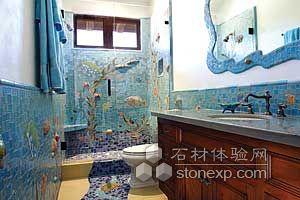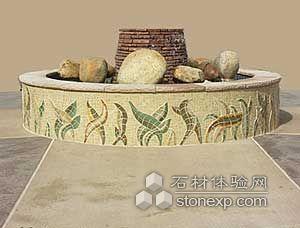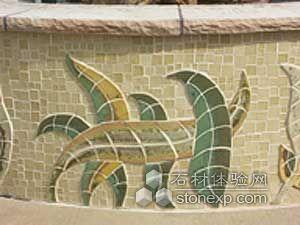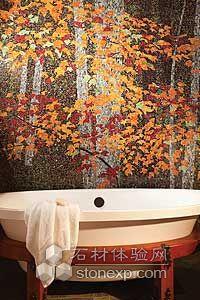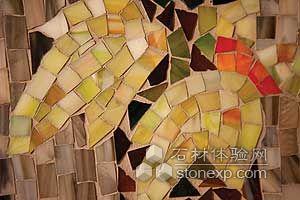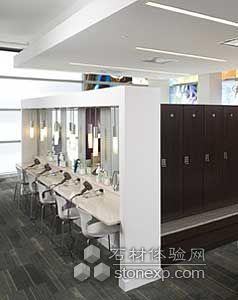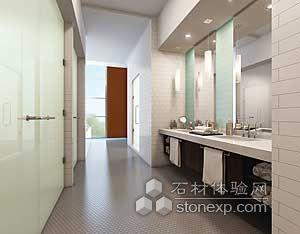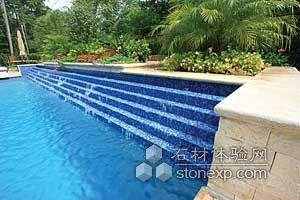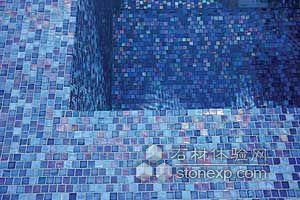Developing Custom Designs with Mosaics
|
With a broad range of custom color blends and sizes, mosaics continue to be a leading choice for designers, architects and even homeowners in making a design unlike any other. Whether mosaics are taking on an artistic form or providing a complementary element to a granite countertop or large-format tile floor, the different varieties of mosaics have allowed designers and architects to provide an artistic touch to their projects. From framing a bathroom mirror to creating decorative accents for an outdoor swimming pool, mosaics can offer unique and custom looks that many homeowners desire. Specifically, hand-made mosaics can be prepared “site specific” — providing an unrivaled design. Designer and tile manufacturer Michelle Griffoul, owner of Michelle Griffoul Studios, Inc. in Buellton, CA, offers her clients custom blends and made-to-order designs that call for true craftsmanship in each mosaic. “We buy raw clay, and we make everything by hand,” she said. “Most of our projects are site specific, made for that particular installation.” The designer recently completed two custom mosaic projects. Both were inspired by elements from the outdoors.
Griffoul created handmade mosaics for the entire project. “I made a paper template for the leaves [that was] 10 percent bigger than the finished job because porcelain shrinks 10 to 12 percent in drying and firing,” she said. “This job was a very fast turnaround, and we designed and made it in one month. I drew out the design after seeing a rough draft from the client and got approval of my interpretation of what they wanted. We then went to work very quickly. The clay has to be cut out by hand and dried slowly to prevent warpage"
Additionally, her craft and carefulness in tile making had to be on point. “Because each leaf is glazed differently, if one part of one leaf broke in the firing, packaging or shipping process, we would have to remake the entire leaf to have it match perfectly because of glazing and shrinking,” she said. “When custom tiles are made by hand, you don’t have a mold that you use a thousand times to use for a perfect fit.”
Conceived to be a unique experience, different from any other lodge at the resort, Lodge 3000 features six presidential master suites with luxury master baths. Heated tile flooring at the vanity, spacious walk-in showers with heated towel warmers and a television within the lighted mirror all come standard. In addition, a freestanding pedestal tub — accented by a floor-to-ceiling glass mosaic mural wall of leaves inspired by the colors of autumn — help define the overall design concept, which Smith said was “refined rustic.”
Altogether, the interior mosaic wall unit measures 7 x 9 feet, and the end unit tub area, which is cantilevered, was designed as two panels measuring 3 feet, 6 inches x 9 feet. Smith explained that the only concerns came with the size of the mural and how to install it.
The exterior of the facility features a glass facade to connect the outdoors to the indoors. And the ultimate goal for the interior space was to craft quality, lifestyle and the right temperament to make the fitness facility unlike any others in town. The designers for the interior, which were from Semple Brown Design of Denver, CO, developed a material palette that reflected Pura Vida’s identity, while integrating the structure’s glass walls.
Pura Vida was recently one of eight commercial projects recognized by Daltile nationwide as top “real life” applications using Daltile products, which is part of Daltile’s inaugural “Visionary Design Award” commercial design contest. Case, along with Dalton Davis, also of Semple Brown Design, were specifically acknowledged for this achievement.
To meet the various goals of the project, Pavlesic selected mosaics from Cactus Stone and Tile of Phoenix, AZ, and Sicis Glass’ custom blending services all throughout the spa area, the pool’s waterline, the cascade wall and the pool’s steps. Additionally, travertine — supplied by QDI of Houston, TX — was his choice for the outer veneer of the raised back wall, planters, coping and deck.
“For the glass mosaic tile, we used a 5/8- x 5/8-inch glass on a staggered joint to create a more dramatic pixilation and break up the continuity of the rows of glass,” said Pavlesic. “The travertine veneer for the raised walls and planters is a 4-inch by random split-face travertine. For the travertine coping, we used a 16- x 24- x 2-inch bullnosed edge to create length and clean lines, while the bull-nosed edge provided a softer and more subtle appearance. The deck is travertine pavers in a Versailles pattern to flow with the geometric design while breaking up all of the straight lines.” |

